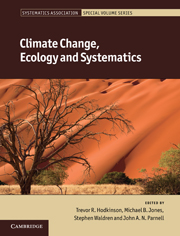Book contents
- Frontmatter
- Contents
- List of contributors
- Preface
- Section 1 Introduction
- Section 2 Adaptation, speciation and extinction
- Section 3 Biogeography, migration and ecological niche modelling
- Section 4 Conservation
- 16 Assessing the effectiveness of a protected area network in the face of climatic change
- 17 Documenting plant species in a changing climate: a case study from Arabia
- 18 A critical appraisal of the meaning and diagnosability of cryptic evolutionary diversity, and its implications for conservation in the face of climate change
- 19 Climate change and Cyperaceae
- 20 An interdisciplinary review of climate change trends and uncertainties: lichen biodiversity, arctic–alpine ecosystems and habitat loss
- 21 Climate change and oceanic mountain vegetation: a case study of the montane heath and associated plant communities in western Irish mountains
- Index
- Systematics Association Publications
- Plate section
- References
16 - Assessing the effectiveness of a protected area network in the face of climatic change
from Section 4 - Conservation
Published online by Cambridge University Press: 16 May 2011
- Frontmatter
- Contents
- List of contributors
- Preface
- Section 1 Introduction
- Section 2 Adaptation, speciation and extinction
- Section 3 Biogeography, migration and ecological niche modelling
- Section 4 Conservation
- 16 Assessing the effectiveness of a protected area network in the face of climatic change
- 17 Documenting plant species in a changing climate: a case study from Arabia
- 18 A critical appraisal of the meaning and diagnosability of cryptic evolutionary diversity, and its implications for conservation in the face of climate change
- 19 Climate change and Cyperaceae
- 20 An interdisciplinary review of climate change trends and uncertainties: lichen biodiversity, arctic–alpine ecosystems and habitat loss
- 21 Climate change and oceanic mountain vegetation: a case study of the montane heath and associated plant communities in western Irish mountains
- Index
- Systematics Association Publications
- Plate section
- References
Summary
Abstract
Climatic change is expected to result in changes in species' distributions. However, current networks of protected areas, designed to conserve biodiversity, have been designated and designed on the basis of a paradigm of long-term stability of species' geographical distributions. As a result, these networks may not be effective in conserving biodiversity in a world with rapidly changing climatic conditions. We investigate this using as a model system the 1679 bird species breeding in sub-Saharan Africa and the network of 803 Important Bird Areas (IBAs) designated in the region by Bird Life International. Using climatic envelope models fitted to species' present distributions and the current climate, species' present and potential future occurrences in IBAs were simulated. The results show that the current network has the potential to maintain most species throughout the present century. However, they also indicate that this outcome depends upon substantial potential species turnover in many IBAs. This is only likely if the connectivity of the current network is enhanced substantially in key areas, and will also depend upon sympathetic management of the wider landscape, so as to enhance its permeability, and appropriate management of individual sites, taking into account their role in the overall network.
Introduction
It is now generally accepted that anthropogenic activities have resulted in global climatic changes over the past century (Trenberth et al.,2007); they may even have done so over several millennia (Ruddiman, 2003).
- Type
- Chapter
- Information
- Climate Change, Ecology and Systematics , pp. 345 - 364Publisher: Cambridge University PressPrint publication year: 2011
References
- 3
- Cited by

